Diving Dominica North to South

A diver explores a Dominica reef
Michele Westmorland
Dominica beckons divers with an independent and adventurous streak. While the island's southern dive sites are known for dramatic pinnacles and prolific marine life, its northern ones boast spectacular underwater cave systems and rock formations. Diving in both of the island's distinct geographic regions doesn't come pre-packaged, but do some independent legwork and brainstorm with multiple operators and you can experience all the diving Dominica has to offer, from the south to the north.
South - Pinnacle Paradise
It's all about the underwater topography here, created by some heavy-duty ancient volcanic events. The region's 25 dive sites are clustered offshore from the capital, Roseau, down to Scotts Head, a knob on the island's extreme southwestern end. Of those sites, a little more than half are in sheltered Soufriere Bay. The region also includes the Soufriere Scotts Head Marine Reserve. You can experience the south's pinnacles by diving in as little as 20 to 30 feet of water, but deep dives with drop-offs in excess of 100 feet are also an option.
Underwater Escapes
Dangleben's Pinnacles Spectacular underwater peaks pierce the surface here, inside Soufriere Bay. Dangleben's is a deep dive of 90 feet or more and it's done from the north, west or south. The pinnacles are located in a submerged crater and from the south, you can descend down the top of one pinnacle at 25 feet, then head south toward a sandy valley to look for seahorses and frogfish. Along with the elephant ear sponges and trademark barrel sponges, there's rich animal life, from green morays and jacks to wahoo and tuna. Turtles are also in the house and criss-crossing Creole wrasse and blue chromis create an overload of color.
Scotts Head Pinnacle The top of this underwater volcanic peak is only four feet from the surface and with a maximum depth of 75 feet, it's not quite as deep as Dangleben's. It's located just beyond Soufriere Bay, so it's exposed to strong currents. By keeping your mask down and kicking hard, you'll come around the pinnacle and discover some nifty swim-throughs, including the entrance to another site, Swiss Cheese. You can squeeze through some inviting, snapper-laden caves and also check out the barrel and fan-studded surroundings. There are a few other nice treats here, too: huge French angelfish and Caribbean slipper lobsters.
Champagne This is the northernmost site in Soufriere's Scotts Head Marine Reserve. Volcanic activity forces gasses to seep through the seafloor or cracks in the underlying rock, creating a bubble effect. You'll know you're near the source--a vent the size of a Jacuzzi hose--when the escaping steam fogs up your mask. With a 60-foot maximum depth, you'll have lots of bottom time. Pederson cleaner shrimp busily tidy up spotted moray eels' mouths and schools of silversides form shimmery clouds around divers.
Coral Gardens This site, on a connecting ridge to Dangleben's, has a max depth of only 50 feet. Peer under the ledges and get an extreme close-up view of a sleeping nurse shark, often guarded by a security phalanx of blackbar soldierfish. This area is also a prime cleaning station, where shrimp service spotted morays. If you're really lucky you'll see a scorpionfish raise its colorful orange-black-and-white pectoral fins.
Topside Temptations
Roseau The bustling capital city, pronounced "Roo-ZOH," is easily walkable and its day and night markets are well worth checking out. The most intriguing shop is a spice market called the Ruins.
Soufriere Sitting down at an open-air snackette in this petite fishing village for a plate of delicious fresh fish or chicken is a must. Soufriere (pronounced soo-FREE-yeh) swells to about 10 times its normal population during the day-long Kubuli Carib Canoe Race during the island's annual Dive Fest.
Trafalgar Falls Hire a licensed guide — $10 U.S. per person is generous — who'll take you to a series of natural pools near the waterfalls. If you're up for adventure, follow the guide along the rocks and into the large swimming holes directly underneath the plummeting waterfalls. Later in the afternoon the crowds thin out and you just may have this piece of paradise all to yourself.
Boiling Lake and the Valley of Desolation Pack a hearty lunch, plenty of water and bring your hiking A-game for this strenuous 5-mile climb through some of Dominica's highest peaks. Hiring a licensed guide here is a must for safety. You'll pass through rainforest, deciduous forest and a beautifully barren, sulphur-perfumed cleft between mountain peaks, appropriately called the Valley of Desolation. Your ultimate reward is a real boiling lake, blowing off steam. If you're adventurous, scale down the rocks to the lake surface. A rain poncho is essential.
Titou Gorge It's at the start of the Boiling Lake hike, near an old hydroelectric station, and makes for either an ideal post-hike cool down, or full or half-day excursion. Swim through the gorge, flanked by steep natural walls, to a waterfall inside. After cooling down, you can warm right back up in nearby hot springs.
North - Rugged and Rocky
This region has about 20 different dive sites and the currents are a little stronger than down south, depending on the time of the year. The north shares the south's volcanic underwater topography and sports some nice reefs. The action goes down in Prince Rupert Bay and around the Cabrits Peninsula, in Douglas Bay and Toucari Bay. There's an awesome underwater cave system to delight swim-through fiends, rock formations teeming with macro life, one well-kept secret reef and even a muck dive, where sharp-eyed divers can find camouflaged critters.
Underwater Escapes
Toucari Caves In this phenomenal Toucari Bay site there are many arches and swim-through passages and tunnels to explore. These are all patrolled by blackbar soldierfish and glasseye sweepers and lined with black urchins. The site is extraordinarily colorful and a nearby river carries in discarded coconut husks, in which frogfish like to take shelter. You'll descend over two large boulders on a reef at about 40 feet and the temptation is to immediately explore them. But be patient. You'll eventually return after dropping down to 90 feet, swimming north and eventually zigzagging back. Hard and soft corals also come in a myriad of colors and a spotted eagle ray or turtle might make a cameo appearance.
Pole to Pole The lights of the old Prince Rupert Bay pier, at the entrance to Cabrits National Park, attract tons of baitfish, and spiraling encrusting corals hang from the poles like wasps' nests. It's 48 feet at its deepest, giving divers tons of time with all the macro life, including seahorses, frogfish and jawfish, among the debris of engine blocks and tires. You can dive the pier from the beach or a dive boat; by day or by night. Just pinball from one pole to another to see it all.
Tube Reef Here's a recently discovered spot adjacent to Toucari Caves that's about a 10- to 15-minute surface swim from a beach in the village of Toucari. Descend past coral boulders at 20 feet, then drop down into the sand. There, you'll catch comical performances--jawfish peeping their heads in and out of their hiding places and yellowline arrow crabs using their spindly arms and purple pincers to stuff their mouths with nutrients while feverishly scratching themselves. There's incredible color variety of sponges here, from fat purple barrels to delicate turquoise vases.
Five-Finger Rock This underwater site in Douglas Bay, at the north end of Cabrits Peninsula, once was shaped like the five digits on a human hand, but now it's more like a thumb. The formation gradually slopes down between 80 and 90 feet, with coral heads literally crawling with critters, including banded coral shrimp and yellowline arrow crabs foraging for nutrients. But the unexpected headliners here are Caribbean reef squid, traveling in a synchronized formation and flitting about like neon hummingbirds, with their colors morphing from purple to brown to gold to red.
Topside Temptations
Portsmouth Food Stalls Don't miss loading up on delicious homemade foods like local bakes (fried dumplings, a la Johnny cakes) and fried chicken and drinks like fresh fruit shakes and smoothies from the assemblage of food stalls in Portsmouth. Stock up for the perfect surface interval snack or post-dive spread.
Kalinago Barana Aute: The Carib Cultural Village The Kalinago, Dominica's original inhabitants, whose numbers are now about 4,000, have preserved their heritage here at a cliffside reserve on the island's northeast coast. Along with St. Vincent, this is the only Caribbean island whose indigenous people survived European conquest. A documentary shown at a visitor's center introduces the culture, and guides will show you traditional houses and canoes. Shop at the native craft stalls for woven baskets or masks. Visit kalinagobaranaaute.com for information on cultural performances, admission and days and hours of operation.
Indian River If you're a fan of Pirates of the Caribbean, this excursion, which begins near Portsmouth, is a must, because part of one of the movies was filmed here. Hop on board a dugout canoe and your captain will take you through a mangrove swamp and into a shrouded canopy of green. The deeper into the forest on the river you travel, the wilder the scenery gets.
Cabrits National Park Take a short trip from Portsmouth for stunning views of the island's northwest coastline and a little history to boot. The park incorporates protected tropical rainforest and wetlands--and some of the stone buildings of Fort Shirley, a colonial era British military encampment. There are easily accessible and low-stress nature walks here.
Getting There & Around
If you want to dive Dominica from north to south on one trip, you'll have to do some legwork before arriving on island. Log on to discoverdominica.com or dominicawatersports.com for a complete listing of dive operators in both regions. Once you find shops you like, e-mail them for help in arranging accommodations in their partner resorts, guest houses or apartments. If you plan to stay a few days or even a week in one area and equal time in the other, you'll need a rental car. Dive operators, resorts and hotels can arrange for one to be dropped off for you.
Because Dominica's tiny international airport--Melville Hall (DOM)--can't support big jets, there are no nonstop flights between the island and the U.S. mainland. Most divers fly into San Juan, Puerto Rico, and overnight there before arriving in Dominica. Plenty of carriers fly to San Juan, with American offering daily mid-morning nonstops from there to Dominica. It's possible to reach Dominica in one day--with multiple connections on multiple carriers--from some U.S. cities.
Once you're on the island, your dive operator, resort or hotel has the 90-minute transfer from the airport to Roseau covered. Roseau, with its proximity to dive operators, accommodations, topside attractions and rental car agencies, is the ideal place to start. From Roseau, it's an hour's drive north to Portsmouth, near the island's best northern dive sites and topside activities. Another option is staying mid-island, in or near Salisbury, about a 20-minute drive south from Portsmouth, and a short boat ride to dive sites like Rena's Hole and Whale Shark Reef. If you're driving a rental car, allow plenty of time to get around on the narrow, twisting mountain roads and mind the blind curves.
To Dive Dominica
Dive Fest Is Best
If you or your local dive club buddies are considering spending some quality bottom time in Dominica, July is the best time, during the country's annual Dive Fest, put on by the Dominica Watersports Association. Dive Fest 2009 is scheduled for Friday, July 10, through Sunday July 19. You can take advantage of dive deals offered by participating shops, take land excursions and compete for prizes in underwater photography contests. dominicawatersports.com.
Thank You To
Fort Young Hotel
fortyounghotel.com
Discover Dominica Tourism Authority
discoverdominica.com
Dominica Watersports Association
dominicawatersports.com
Nature Island Dive
natureislanddive.com
Anchorage Hotel Whale Watch & Dive Center
anchoragehotel.dm
Cabrits Dive Center
cabritsdive.com
East Carib Dive
east-carib-dive.com
Sunset Bay Club Beach Hotel
sunsetbayclubhotel.com
Dive Dominica
divedominica.com
Jon Vee Tours
visit-dominica.com
Resources
Fort Young Hotel
fortyounghotel.com
800-581-2034
Discover Dominica Tourism Authority
discoverdominica.com
767-448-2045
Dominica Watersports Association
dominicawatersports.com
Dive Dominica/Castle Comfort Lodge
divedominica.com
646-502-6800
Caradonna Dive Adventures
caradonna.com/Destination/Dominica.aspx
800-328-2288
InDepth
Getting There: Most travelers fly into Dominica's Melville Hall Airport (DOM), on the island's northeast coast, one-and-a-half-hours from Roseau. North American travelers will find it tough to reach Dominica in one day, but with connecting flights to the island out of Puerto Rico, spending a night in San Juan can be a good option. If you've got the time, explore Old San Juan by walking along the narrow cobblestone streets where you'll find everything from open-air bars, great restaurants, coffehouses and nightclubs. By day, walk to and explore El Morro, the sprawling fort, or take a taxi or trolley to the Casa Bacardi Rum Distillery for a tour. There are also land tours available from San Juan hotels to the Arecibo Radio Telescope & Observatory, and for nature lovers, there are excursions available to the Camuy River Cave Park and the El Yunque Rainforest. For more information, visit gotopuertorico.com. For more details on getting to Dominica, see "Getting There & Around".
Getting Around: Exploring the island is easiest if you rent a car, though if you find driving on twisty roads through the rainforest challenging, it's easy to arrange a taxi. If you rent a car, you must get a driver's license which costs EC$30 (US$12). You must be between 25 and 65 years old, with two years' driving experience. Driving is on the left side of the road.
The Diving: Water temps are in the high 70s in winter and mid-80s in summer, and vis ranges from 60 to 100 feet. The rainy season is July to October. You'll pay an entrance fee to your dive operator before entering the Soufriere Scotts Head Marine Reserve. It's US$2 per dive, or US$20 for a weeklong pass.
Entry Documents: A passport and an onward or returning ticket is required.
Money Matters: Currency is the Eastern Caribbean dollar (EC$); the exchange rate is about EC$2.67 to US$1. Departure tax is $30.
Tourism and Info: Discover Dominica Tourism Authority, dominica.dm; Dominica Watersports Association, dominicawatersports.com.
Dominica beckons divers with an independent and adventurous streak. While the island's southern dive sites are known for dramatic pinnacles and prolific marine life, its northern ones boast spectacular underwater cave systems and rock formations. Diving in both of the island's distinct geographic regions doesn't come pre-packaged, but do some independent legwork and brainstorm with multiple operators and you can experience all the diving Dominica has to offer, from the south to the north.
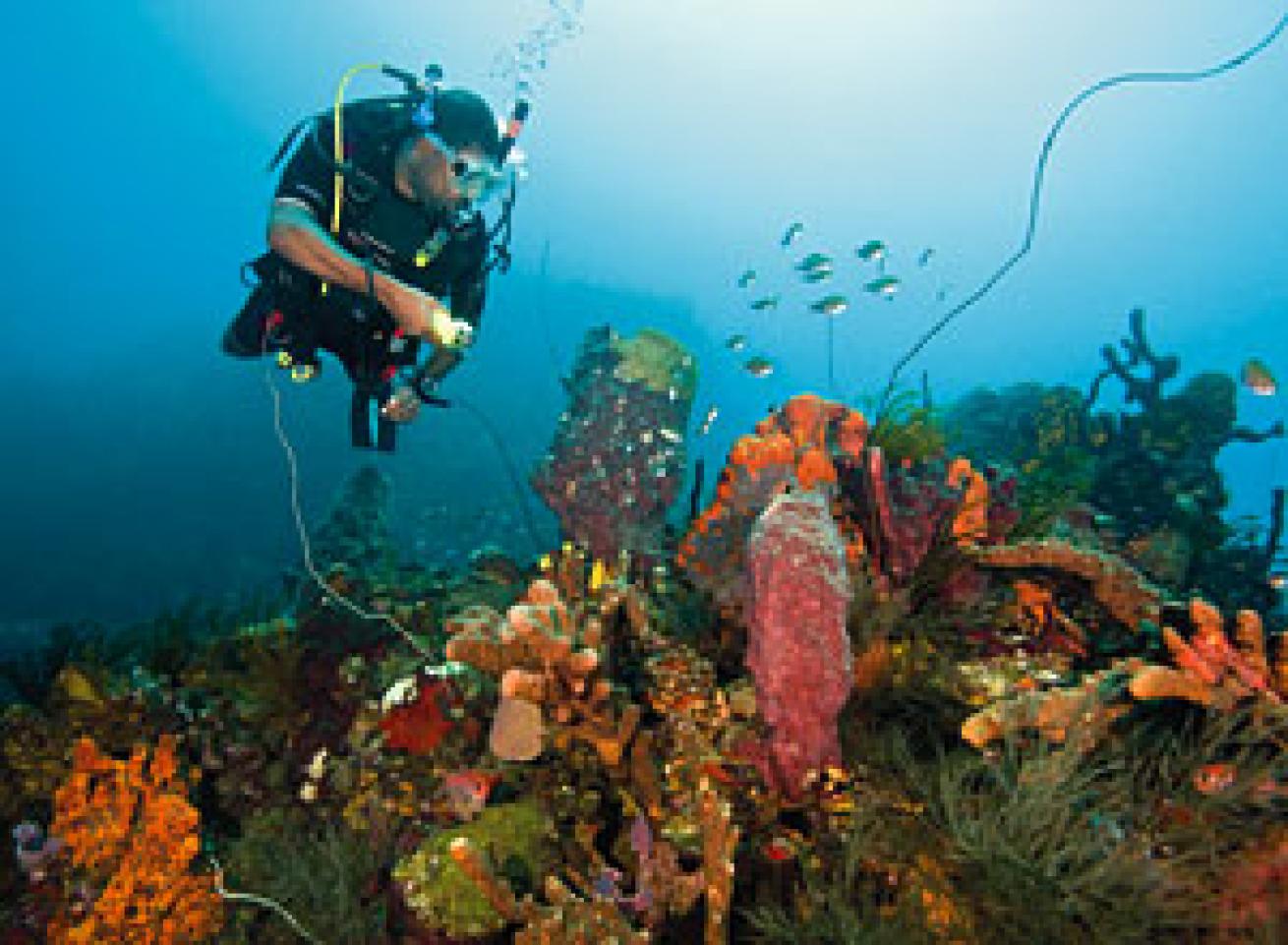
Michele Westmorland.
South - Pinnacle Paradise
It's all about the underwater topography here, created by some heavy-duty ancient volcanic events. The region's 25 dive sites are clustered offshore from the capital, Roseau, down to Scotts Head, a knob on the island's extreme southwestern end. Of those sites, a little more than half are in sheltered Soufriere Bay. The region also includes the Soufriere Scotts Head Marine Reserve. You can experience the south's pinnacles by diving in as little as 20 to 30 feet of water, but deep dives with drop-offs in excess of 100 feet are also an option.
Underwater Escapes
Dangleben's Pinnacles Spectacular underwater peaks pierce the surface here, inside Soufriere Bay. Dangleben's is a deep dive of 90 feet or more and it's done from the north, west or south. The pinnacles are located in a submerged crater and from the south, you can descend down the top of one pinnacle at 25 feet, then head south toward a sandy valley to look for seahorses and frogfish. Along with the elephant ear sponges and trademark barrel sponges, there's rich animal life, from green morays and jacks to wahoo and tuna. Turtles are also in the house and criss-crossing Creole wrasse and blue chromis create an overload of color.
Scotts Head Pinnacle The top of this underwater volcanic peak is only four feet from the surface and with a maximum depth of 75 feet, it's not quite as deep as Dangleben's. It's located just beyond Soufriere Bay, so it's exposed to strong currents. By keeping your mask down and kicking hard, you'll come around the pinnacle and discover some nifty swim-throughs, including the entrance to another site, Swiss Cheese. You can squeeze through some inviting, snapper-laden caves and also check out the barrel and fan-studded surroundings. There are a few other nice treats here, too: huge French angelfish and Caribbean slipper lobsters.
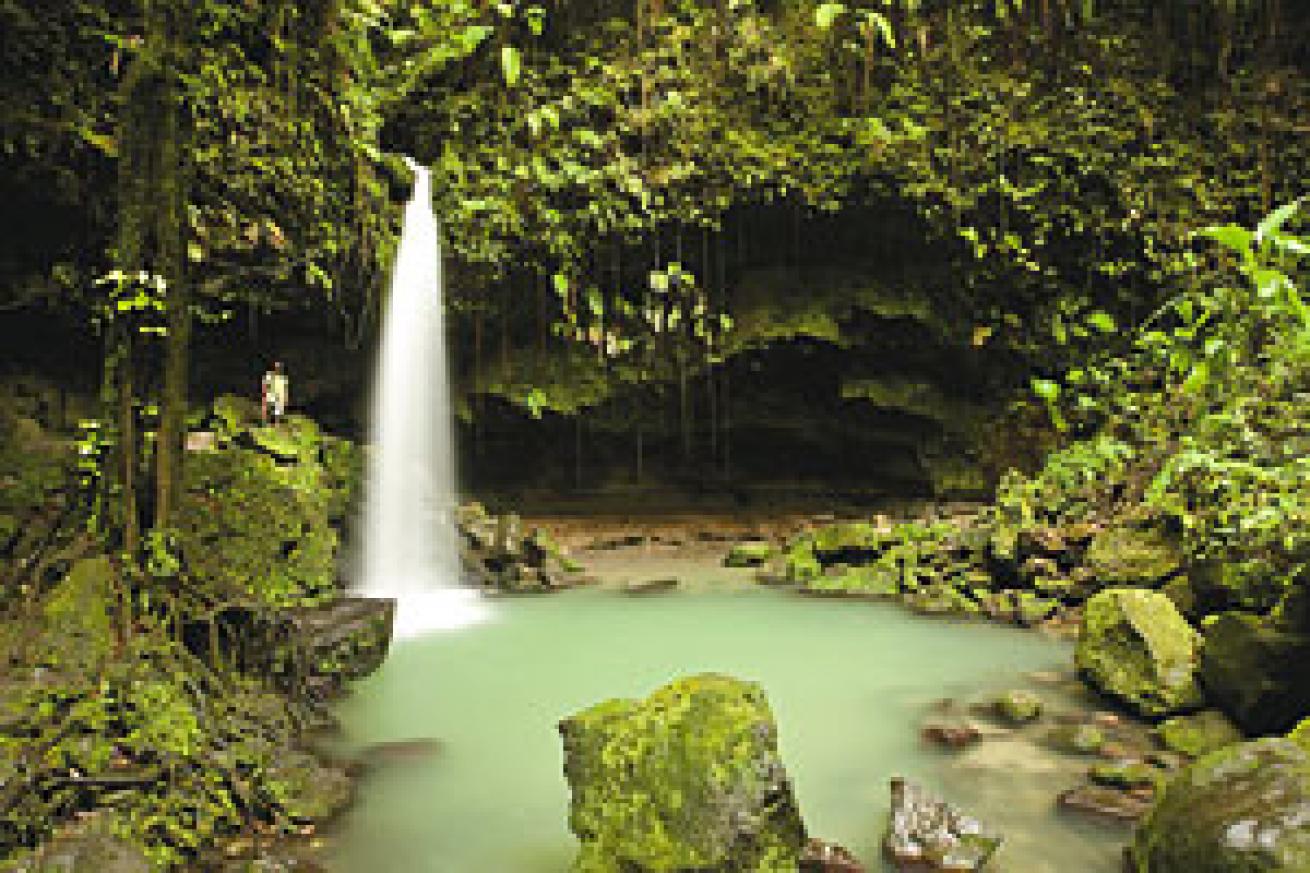
Michele Westmorland.
Champagne This is the northernmost site in Soufriere's Scotts Head Marine Reserve. Volcanic activity forces gasses to seep through the seafloor or cracks in the underlying rock, creating a bubble effect. You'll know you're near the source--a vent the size of a Jacuzzi hose--when the escaping steam fogs up your mask. With a 60-foot maximum depth, you'll have lots of bottom time. Pederson cleaner shrimp busily tidy up spotted moray eels' mouths and schools of silversides form shimmery clouds around divers.
Coral Gardens This site, on a connecting ridge to Dangleben's, has a max depth of only 50 feet. Peer under the ledges and get an extreme close-up view of a sleeping nurse shark, often guarded by a security phalanx of blackbar soldierfish. This area is also a prime cleaning station, where shrimp service spotted morays. If you're really lucky you'll see a scorpionfish raise its colorful orange-black-and-white pectoral fins.
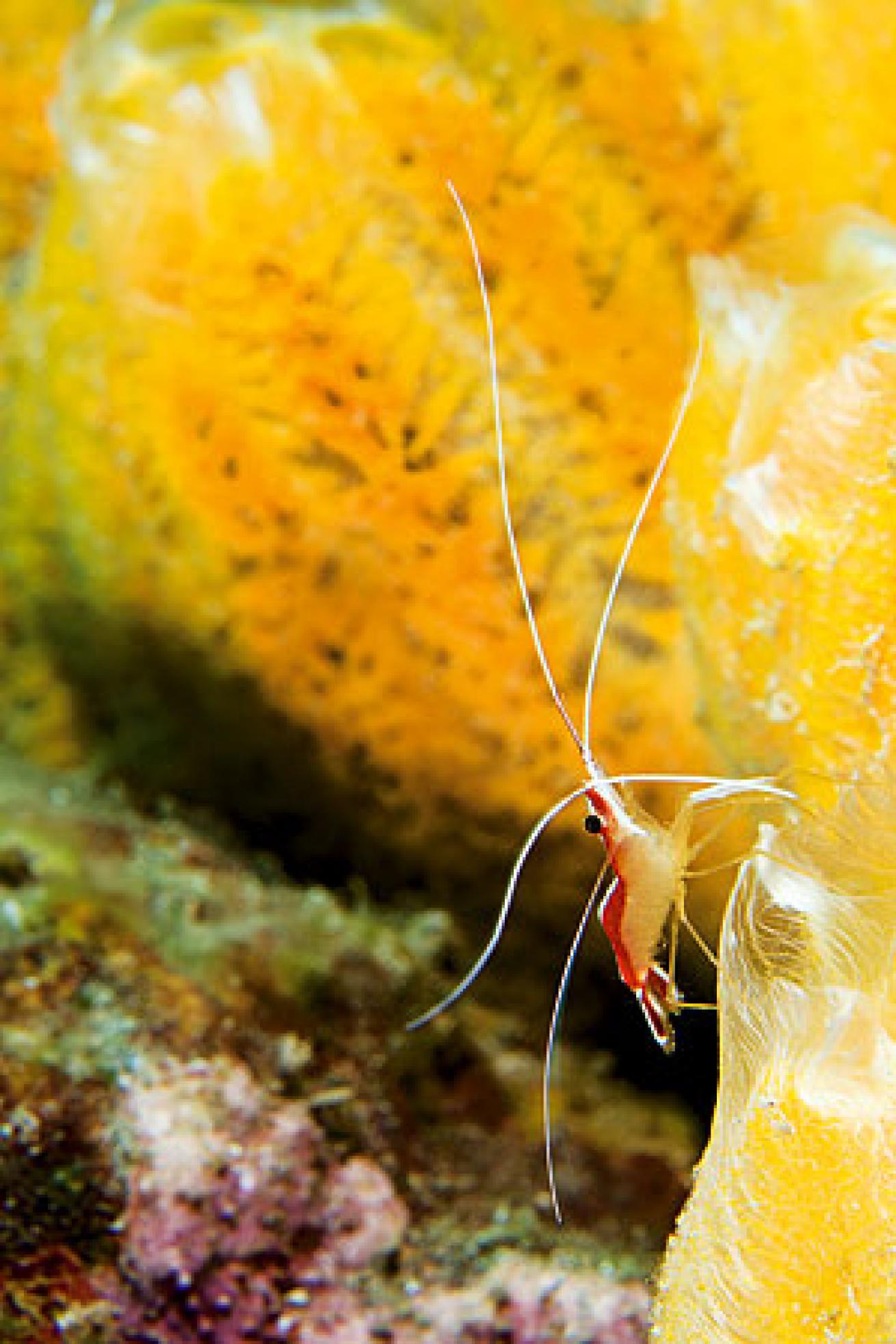
Michele Westmorland.
Topside Temptations
Roseau The bustling capital city, pronounced "Roo-ZOH," is easily walkable and its day and night markets are well worth checking out. The most intriguing shop is a spice market called the Ruins.
Soufriere Sitting down at an open-air snackette in this petite fishing village for a plate of delicious fresh fish or chicken is a must. Soufriere (pronounced soo-FREE-yeh) swells to about 10 times its normal population during the day-long Kubuli Carib Canoe Race during the island's annual Dive Fest.
Trafalgar Falls Hire a licensed guide — $10 U.S. per person is generous — who'll take you to a series of natural pools near the waterfalls. If you're up for adventure, follow the guide along the rocks and into the large swimming holes directly underneath the plummeting waterfalls. Later in the afternoon the crowds thin out and you just may have this piece of paradise all to yourself.
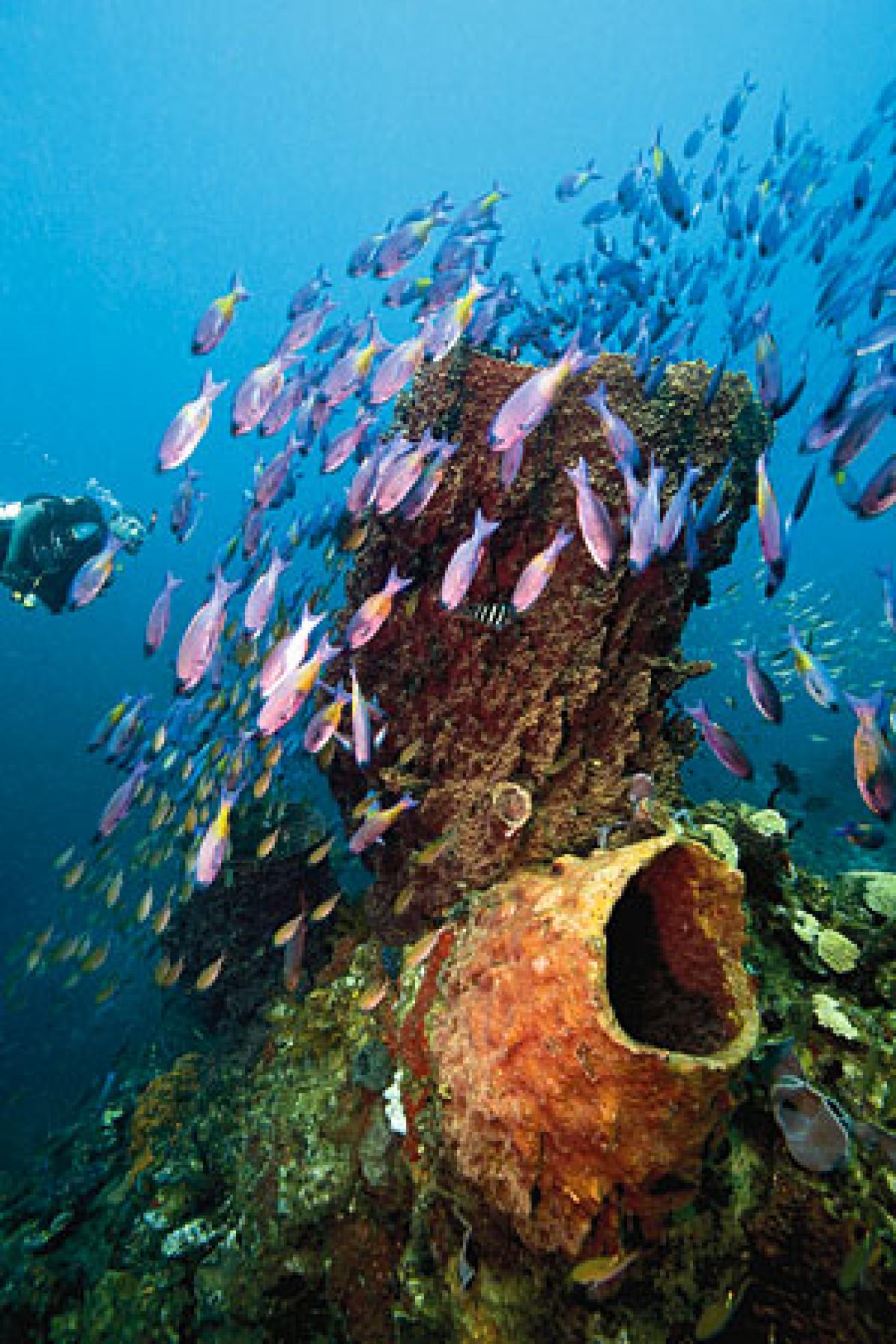
Michele Westmorland.
Boiling Lake and the Valley of Desolation Pack a hearty lunch, plenty of water and bring your hiking A-game for this strenuous 5-mile climb through some of Dominica's highest peaks. Hiring a licensed guide here is a must for safety. You'll pass through rainforest, deciduous forest and a beautifully barren, sulphur-perfumed cleft between mountain peaks, appropriately called the Valley of Desolation. Your ultimate reward is a real boiling lake, blowing off steam. If you're adventurous, scale down the rocks to the lake surface. A rain poncho is essential.
Titou Gorge It's at the start of the Boiling Lake hike, near an old hydroelectric station, and makes for either an ideal post-hike cool down, or full or half-day excursion. Swim through the gorge, flanked by steep natural walls, to a waterfall inside. After cooling down, you can warm right back up in nearby hot springs.
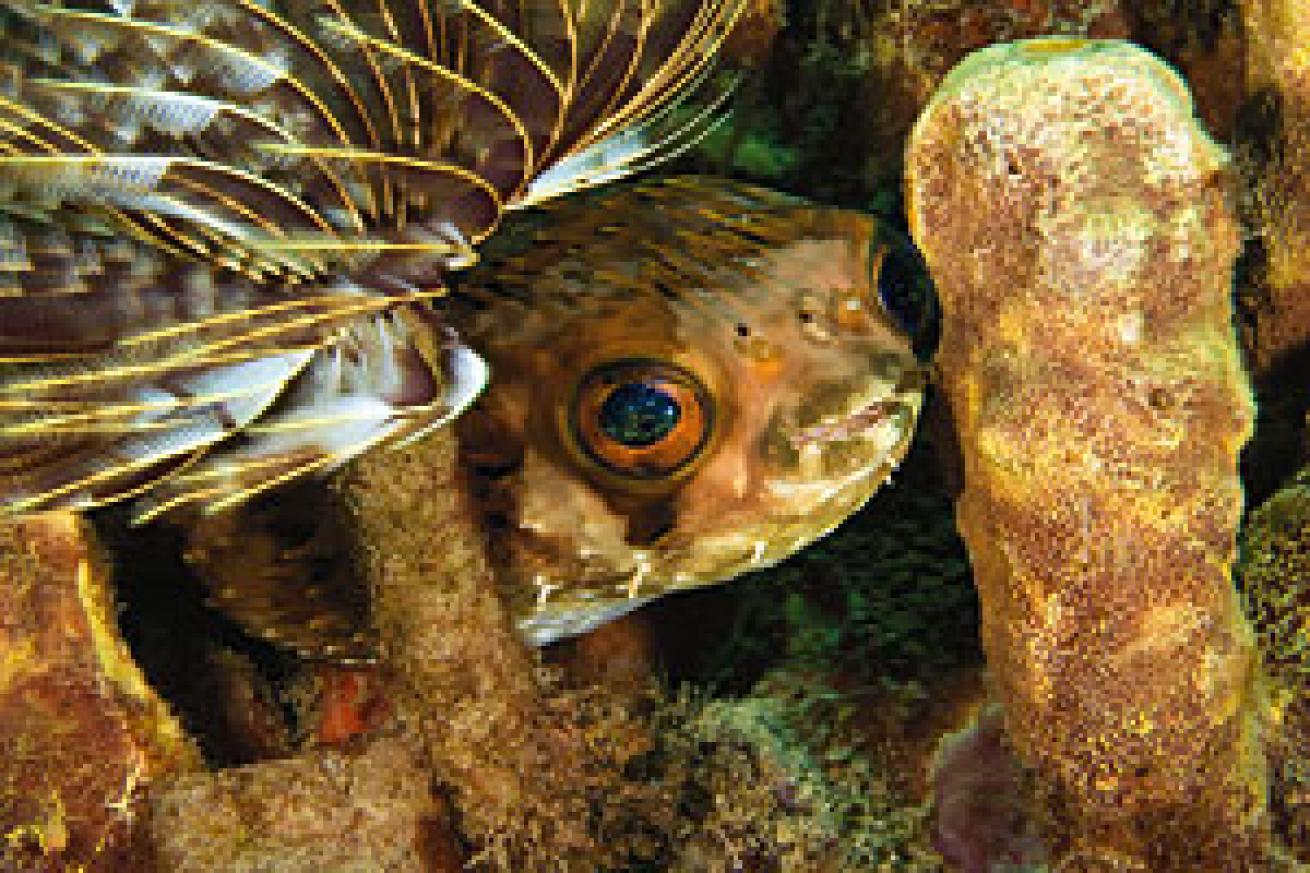
Michele Westmorland.
North - Rugged and Rocky
This region has about 20 different dive sites and the currents are a little stronger than down south, depending on the time of the year. The north shares the south's volcanic underwater topography and sports some nice reefs. The action goes down in Prince Rupert Bay and around the Cabrits Peninsula, in Douglas Bay and Toucari Bay. There's an awesome underwater cave system to delight swim-through fiends, rock formations teeming with macro life, one well-kept secret reef and even a muck dive, where sharp-eyed divers can find camouflaged critters.
Underwater Escapes
Toucari Caves In this phenomenal Toucari Bay site there are many arches and swim-through passages and tunnels to explore. These are all patrolled by blackbar soldierfish and glasseye sweepers and lined with black urchins. The site is extraordinarily colorful and a nearby river carries in discarded coconut husks, in which frogfish like to take shelter. You'll descend over two large boulders on a reef at about 40 feet and the temptation is to immediately explore them. But be patient. You'll eventually return after dropping down to 90 feet, swimming north and eventually zigzagging back. Hard and soft corals also come in a myriad of colors and a spotted eagle ray or turtle might make a cameo appearance.
Pole to Pole The lights of the old Prince Rupert Bay pier, at the entrance to Cabrits National Park, attract tons of baitfish, and spiraling encrusting corals hang from the poles like wasps' nests. It's 48 feet at its deepest, giving divers tons of time with all the macro life, including seahorses, frogfish and jawfish, among the debris of engine blocks and tires. You can dive the pier from the beach or a dive boat; by day or by night. Just pinball from one pole to another to see it all.
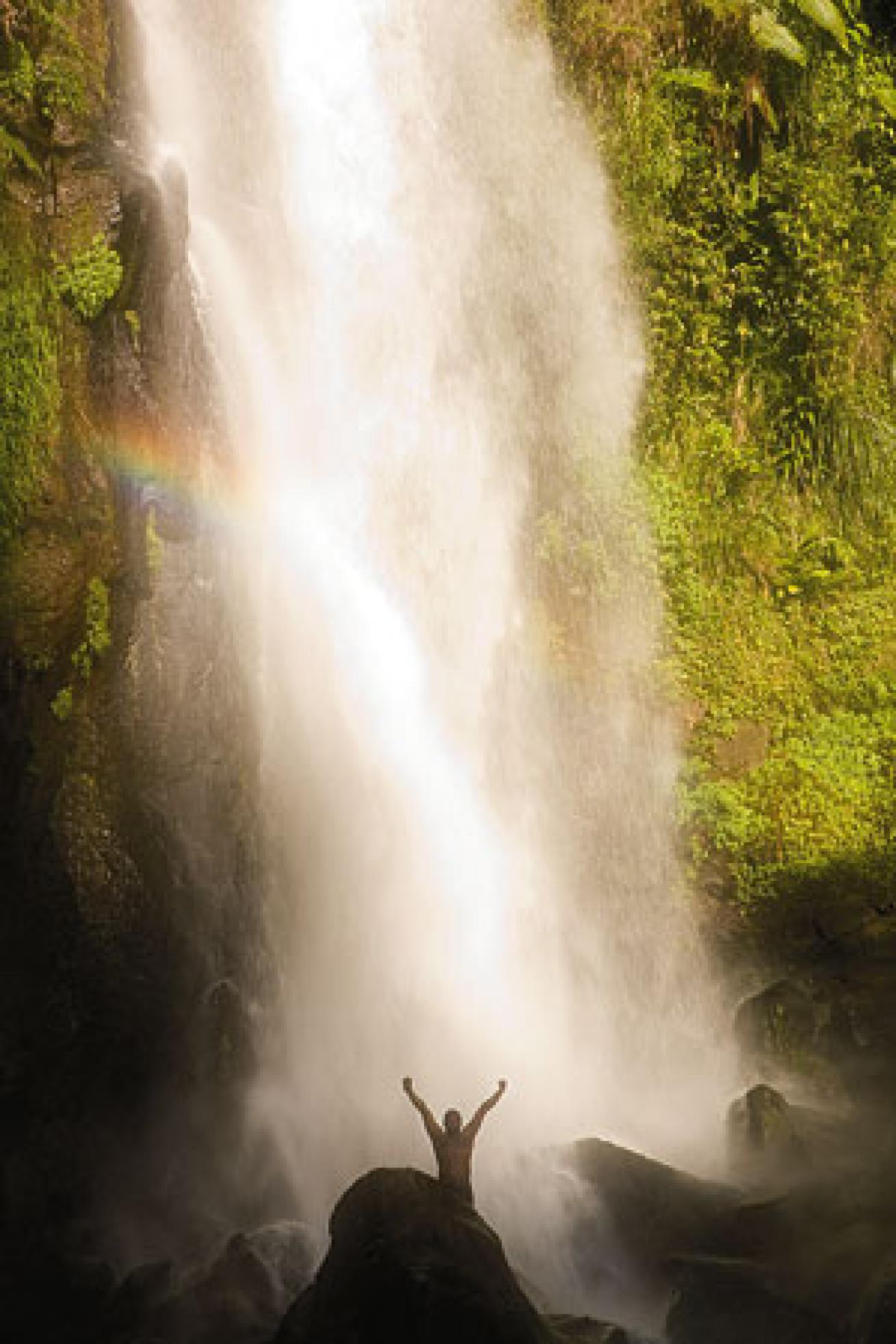
Michele Westmorland.
Tube Reef Here's a recently discovered spot adjacent to Toucari Caves that's about a 10- to 15-minute surface swim from a beach in the village of Toucari. Descend past coral boulders at 20 feet, then drop down into the sand. There, you'll catch comical performances--jawfish peeping their heads in and out of their hiding places and yellowline arrow crabs using their spindly arms and purple pincers to stuff their mouths with nutrients while feverishly scratching themselves. There's incredible color variety of sponges here, from fat purple barrels to delicate turquoise vases.
Five-Finger Rock This underwater site in Douglas Bay, at the north end of Cabrits Peninsula, once was shaped like the five digits on a human hand, but now it's more like a thumb. The formation gradually slopes down between 80 and 90 feet, with coral heads literally crawling with critters, including banded coral shrimp and yellowline arrow crabs foraging for nutrients. But the unexpected headliners here are Caribbean reef squid, traveling in a synchronized formation and flitting about like neon hummingbirds, with their colors morphing from purple to brown to gold to red.
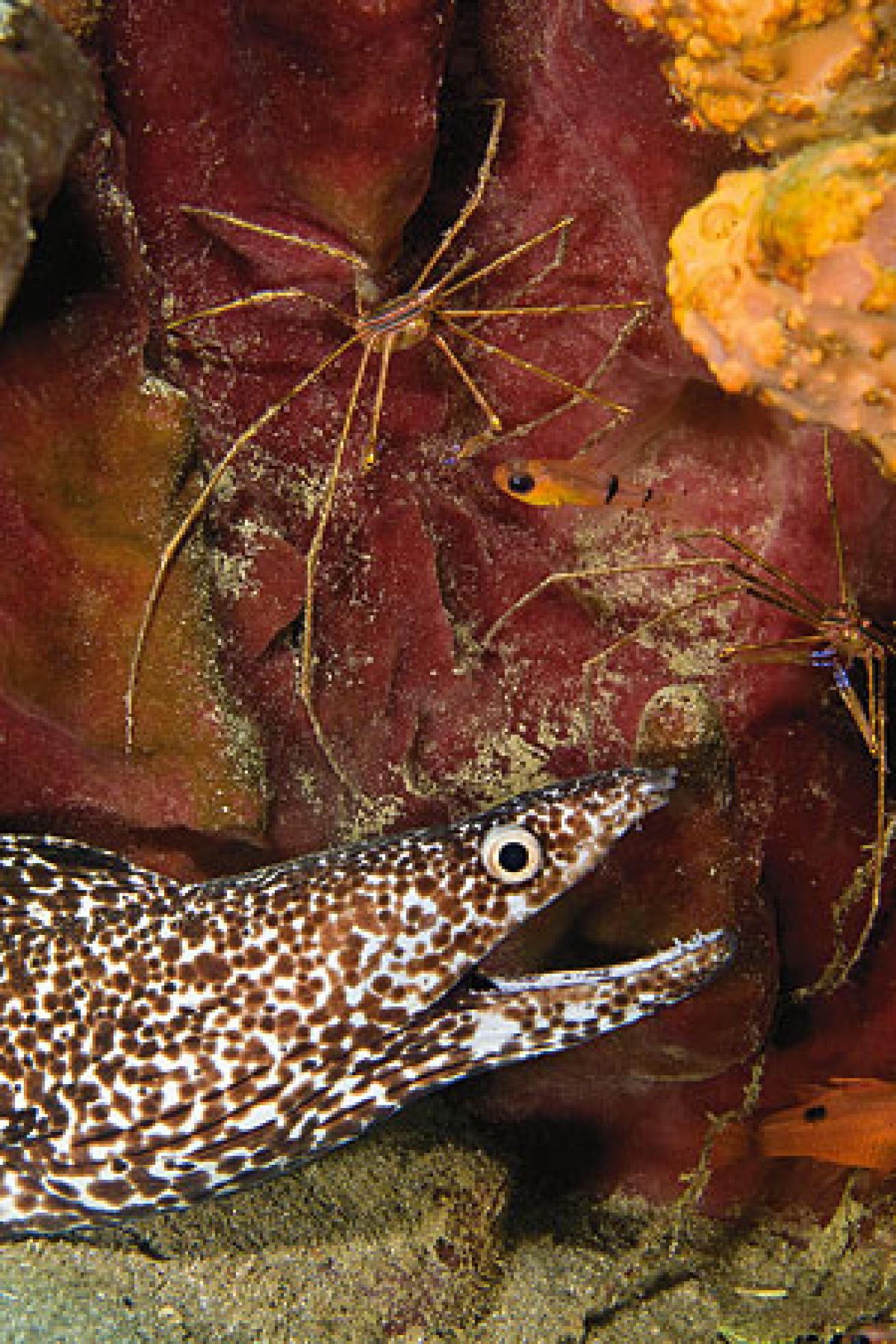
Michele Westmorland.
Topside Temptations
Portsmouth Food Stalls Don't miss loading up on delicious homemade foods like local bakes (fried dumplings, a la Johnny cakes) and fried chicken and drinks like fresh fruit shakes and smoothies from the assemblage of food stalls in Portsmouth. Stock up for the perfect surface interval snack or post-dive spread.
Kalinago Barana Aute: The Carib Cultural Village The Kalinago, Dominica's original inhabitants, whose numbers are now about 4,000, have preserved their heritage here at a cliffside reserve on the island's northeast coast. Along with St. Vincent, this is the only Caribbean island whose indigenous people survived European conquest. A documentary shown at a visitor's center introduces the culture, and guides will show you traditional houses and canoes. Shop at the native craft stalls for woven baskets or masks. Visit kalinagobaranaaute.com for information on cultural performances, admission and days and hours of operation.
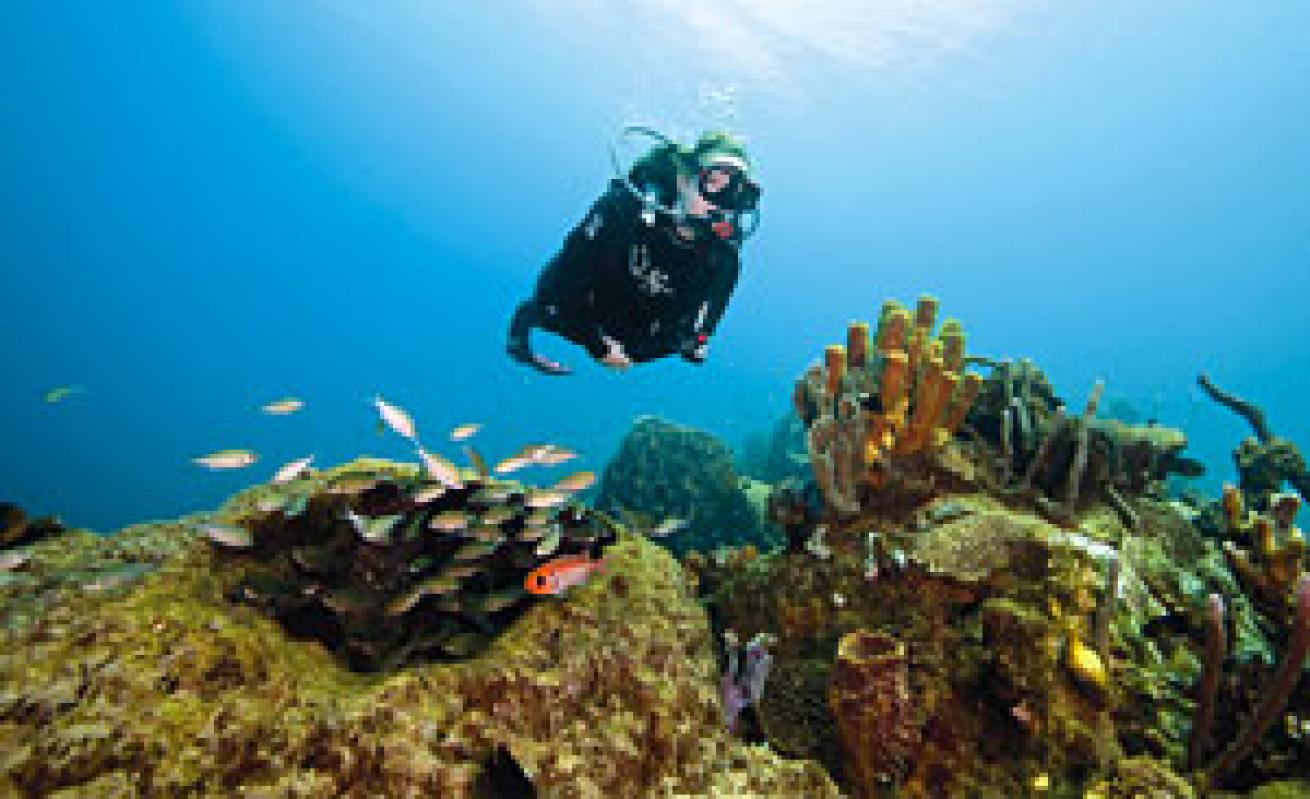
Michele Westmorland.
Indian River If you're a fan of Pirates of the Caribbean, this excursion, which begins near Portsmouth, is a must, because part of one of the movies was filmed here. Hop on board a dugout canoe and your captain will take you through a mangrove swamp and into a shrouded canopy of green. The deeper into the forest on the river you travel, the wilder the scenery gets.
Cabrits National Park Take a short trip from Portsmouth for stunning views of the island's northwest coastline and a little history to boot. The park incorporates protected tropical rainforest and wetlands--and some of the stone buildings of Fort Shirley, a colonial era British military encampment. There are easily accessible and low-stress nature walks here.
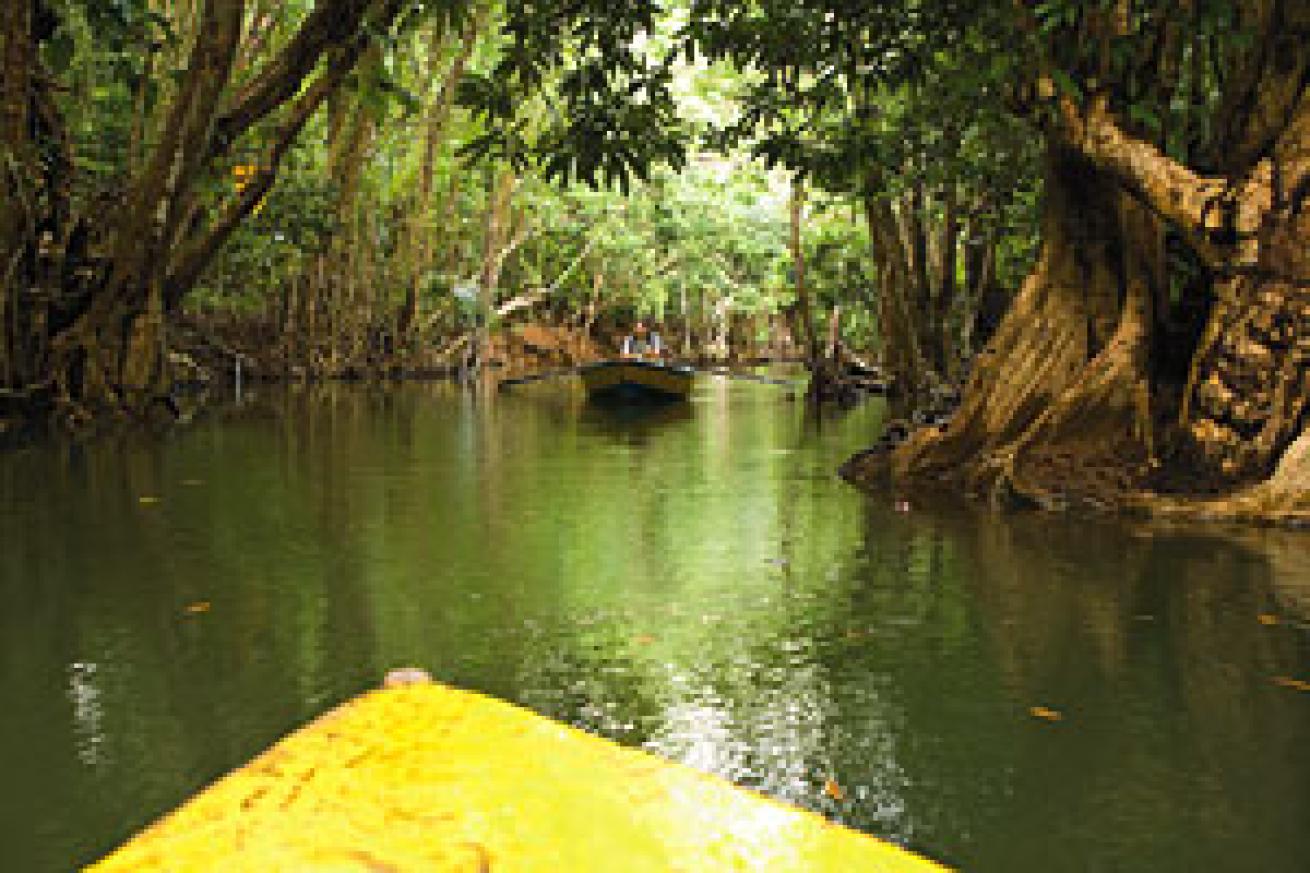
Michele Westmorland.
Getting There & Around
If you want to dive Dominica from north to south on one trip, you'll have to do some legwork before arriving on island. Log on to discoverdominica.com or dominicawatersports.com for a complete listing of dive operators in both regions. Once you find shops you like, e-mail them for help in arranging accommodations in their partner resorts, guest houses or apartments. If you plan to stay a few days or even a week in one area and equal time in the other, you'll need a rental car. Dive operators, resorts and hotels can arrange for one to be dropped off for you.
Because Dominica's tiny international airport--Melville Hall (DOM)--can't support big jets, there are no nonstop flights between the island and the U.S. mainland. Most divers fly into San Juan, Puerto Rico, and overnight there before arriving in Dominica. Plenty of carriers fly to San Juan, with American offering daily mid-morning nonstops from there to Dominica. It's possible to reach Dominica in one day--with multiple connections on multiple carriers--from some U.S. cities.
Once you're on the island, your dive operator, resort or hotel has the 90-minute transfer from the airport to Roseau covered. Roseau, with its proximity to dive operators, accommodations, topside attractions and rental car agencies, is the ideal place to start. From Roseau, it's an hour's drive north to Portsmouth, near the island's best northern dive sites and topside activities. Another option is staying mid-island, in or near Salisbury, about a 20-minute drive south from Portsmouth, and a short boat ride to dive sites like Rena's Hole and Whale Shark Reef. If you're driving a rental car, allow plenty of time to get around on the narrow, twisting mountain roads and mind the blind curves.
To Dive Dominica
Dive Fest Is Best
If you or your local dive club buddies are considering spending some quality bottom time in Dominica, July is the best time, during the country's annual Dive Fest, put on by the Dominica Watersports Association. Dive Fest 2009 is scheduled for Friday, July 10, through Sunday July 19. You can take advantage of dive deals offered by participating shops, take land excursions and compete for prizes in underwater photography contests. dominicawatersports.com.
Thank You To
Fort Young Hotel
fortyounghotel.com
Discover Dominica Tourism Authority
discoverdominica.com
Dominica Watersports Association
dominicawatersports.com
Nature Island Dive
natureislanddive.com
Anchorage Hotel Whale Watch & Dive Center
anchoragehotel.dm
Cabrits Dive Center
cabritsdive.com
East Carib Dive
east-carib-dive.com
Sunset Bay Club Beach Hotel
sunsetbayclubhotel.com
Dive Dominica
divedominica.com
Jon Vee Tours
visit-dominica.com
Resources
Fort Young Hotel
fortyounghotel.com
800-581-2034
Discover Dominica Tourism Authority
discoverdominica.com
767-448-2045
Dominica Watersports Association
dominicawatersports.com
Dive Dominica/Castle Comfort Lodge
divedominica.com
646-502-6800
Caradonna Dive Adventures
caradonna.com/Destination/Dominica.aspx
800-328-2288
InDepth
Getting There: Most travelers fly into Dominica's Melville Hall Airport (DOM), on the island's northeast coast, one-and-a-half-hours from Roseau. North American travelers will find it tough to reach Dominica in one day, but with connecting flights to the island out of Puerto Rico, spending a night in San Juan can be a good option. If you've got the time, explore Old San Juan by walking along the narrow cobblestone streets where you'll find everything from open-air bars, great restaurants, coffehouses and nightclubs. By day, walk to and explore El Morro, the sprawling fort, or take a taxi or trolley to the Casa Bacardi Rum Distillery for a tour. There are also land tours available from San Juan hotels to the Arecibo Radio Telescope & Observatory, and for nature lovers, there are excursions available to the Camuy River Cave Park and the El Yunque Rainforest. For more information, visit gotopuertorico.com. For more details on getting to Dominica, see "Getting There & Around".
Getting Around: Exploring the island is easiest if you rent a car, though if you find driving on twisty roads through the rainforest challenging, it's easy to arrange a taxi. If you rent a car, you must get a driver's license which costs EC$30 (US$12). You must be between 25 and 65 years old, with two years' driving experience. Driving is on the left side of the road.
The Diving: Water temps are in the high 70s in winter and mid-80s in summer, and vis ranges from 60 to 100 feet. The rainy season is July to October. You'll pay an entrance fee to your dive operator before entering the Soufriere Scotts Head Marine Reserve. It's US$2 per dive, or US$20 for a weeklong pass.
Entry Documents: A passport and an onward or returning ticket is required.
Money Matters: Currency is the Eastern Caribbean dollar (EC$); the exchange rate is about EC$2.67 to US$1. Departure tax is $30.
Tourism and Info: Discover Dominica Tourism Authority, dominica.dm; Dominica Watersports Association, dominicawatersports.com.
Get More: scubadiving.com/travel/caribbeanatlantic/dominica










